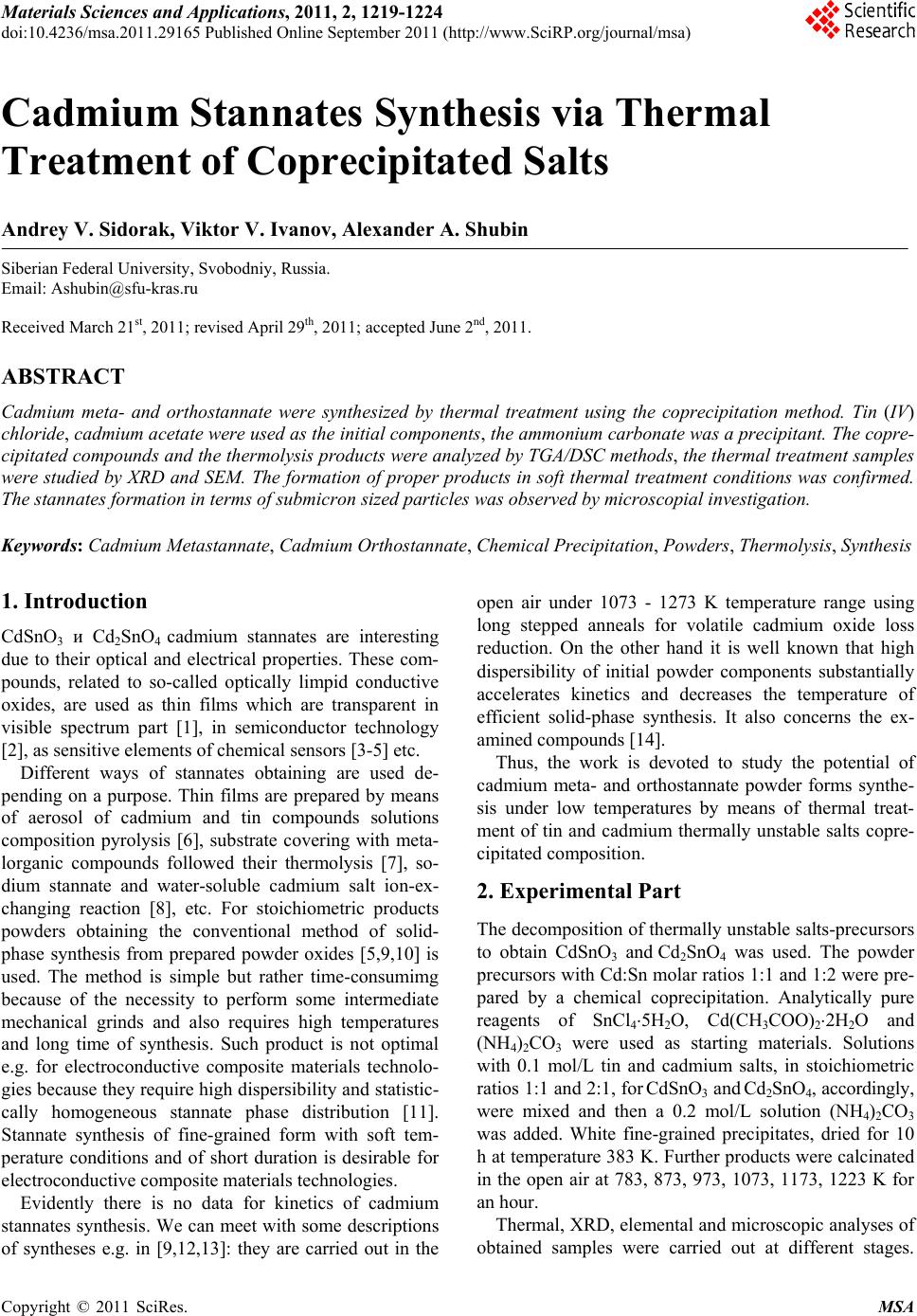
Materials Sciences and Applicatio ns, 2011, 2, 1219-1224
doi:10.4236/msa.2011.29165 Published Online September 2011 (http://www.SciRP.org/journal/msa)
Copyright © 2011 SciRes. MSA
1219
Cadmium Stannates Synthesis via Thermal
Treatment of Coprecipitated Salts
Andrey V. Sidorak, Viktor V. Ivanov, Alexander A. Shubin
Siberian Federal University, Svobodniy, Russia.
Email: Ashubin@sfu-kras.ru
Received March 21st, 2011; revised April 29th, 2011; accepted June 2nd, 2011.
ABSTRACT
Cadmium meta- and orthostannate were synthesized by thermal treatment using the coprecipitation method. Tin (IV)
chloride, cadmium acetate were used as the initia l compon ents, the ammonium carbonate was a precipitant. The copre-
cipitated compounds and the thermolysis products were analyzed by TGA/DSC methods, the thermal treatment samp les
were studied by XRD and SEM. The formation of proper products in soft thermal treatment conditions was confirmed.
The stannates formation in terms of submicron sized particles was observed by microscopial investigation.
Keywords: Cadmium Metastannate, Cadmium Orthostannate, Chemica l Precipitation, Powders, Thermolysis, Synthesis
1. Introduction
CdSnO3 и Cd2SnO4 cadmium stannates are interesting
due to their optical and electrical properties. These com-
pounds, related to so-called optically limpid conductive
oxides, are used as thin films which are transparent in
visible spectrum part [1], in semiconductor technology
[2], as sensitive elements of chemical sensors [3-5] etc.
Different ways of stannates obtaining are used de-
pending on a purpose. Thin films are prepared by means
of aerosol of cadmium and tin compounds solutions
composition pyrolysis [6], substrate covering with meta-
lorganic compounds followed their thermolysis [7], so-
dium stannate and water-soluble cadmium salt ion-ex-
changing reaction [8], etc. For stoichiometric products
powders obtaining the conventional method of solid-
phase synthesis from prepared powder oxides [5,9,10] is
used. The method is simple but rather time-consumimg
because of the necessity to perform some intermediate
mechanical grinds and also requires high temperatures
and long time of synthesis. Such product is not optimal
e.g. for electroconductive composite materials technolo-
gies because they require high dispersibility and statistic-
cally homogeneous stannate phase distribution [11].
Stannate synthesis of fine-grained form with soft tem-
perature conditions and of short duration is desirable for
electroconductive composite materials technologies.
Evidently there is no data for kinetics of cadmium
stannates synthesis. We can meet with some descriptions
of syntheses e.g. in [9,12,13]: they are carried out in the
open air under 1073 - 1273 K temperature range using
long stepped anneals for volatile cadmium oxide loss
reduction. On the other hand it is well known that high
dispersibility of initial powder components substantially
accelerates kinetics and decreases the temperature of
efficient solid-phase synthesis. It also concerns the ex-
amined compounds [14].
Thus, the work is devoted to study the potential of
cadmium meta- and orthostannate powder forms synthe-
sis under low temperatures by means of thermal treat-
ment of tin and cadmium thermally unstable salts copre-
cipitated composition.
2. Experimental Part
The decomposition of thermally unstable salts-precursors
to obtain CdSnO3 and Cd2SnO4 was used. The powder
precursors with Cd:Sn molar ratios 1:1 and 1:2 were pre-
pared by a chemical coprecipitation. Analytically pure
reagents of SnCl45H2O, Cd(CH3COO)22H2O and
(NH4)2CO3 were used as starting materials. Solutions
with 0.1 mol/L tin and cadmium salts, in stoichiometric
ratios 1:1 and 2:1, for CdSnO3 and Cd2SnO4, accordingly,
were mixed and then a 0.2 mol/L solution (NH4)2CO3
was added. White fine-grained precipitates, dried for 10
h at temperature 383 K. Further products were calcinated
in the open air at 783, 873, 973, 1073, 1173, 1223 K for
an hour.
Thermal, XRD, elemental and microscopic analyses of
obtained samples were carried out at different stages.